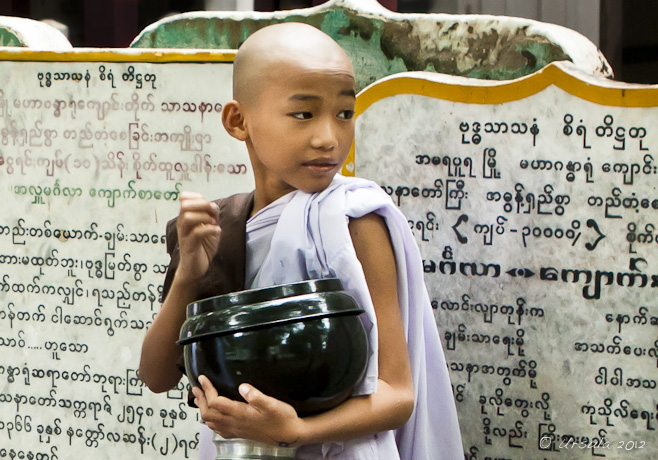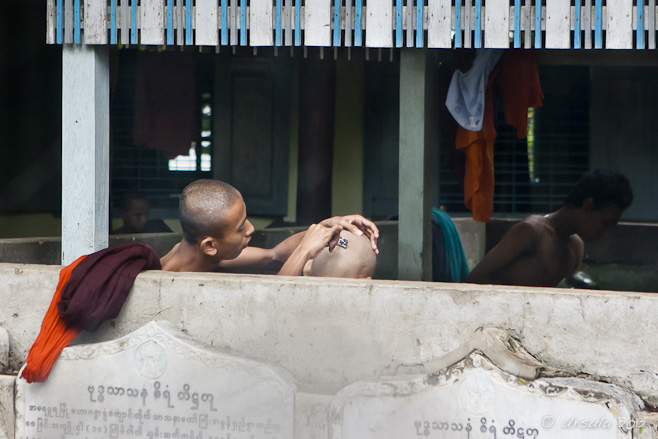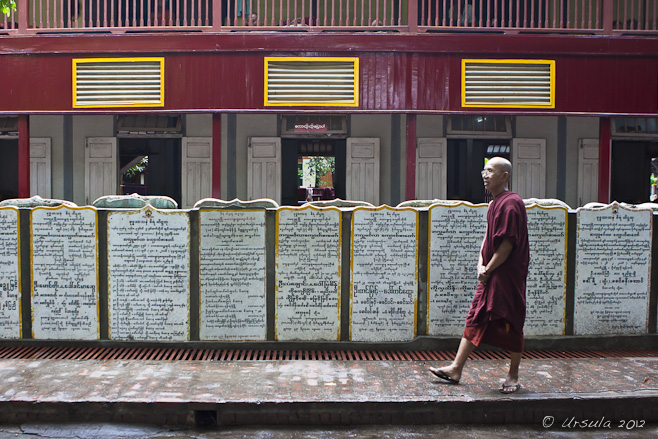
Phothudaw (ဖိုးသူတော်) – Acolyte
Mahagandayon Monastery, Amarapura
It is a different world…
Temples and monasteries are an integral part of life in Myanmar. They accommodate about half a million males, who are either vocational monks or novices, and around 50,000 nuns. That is: roughly one percent of the population actually lives in one of the many monasteries or nunneries, completely dependent on the laity for all their material needs.
Theravada Buddhist monastic life has a strict daily routine revolving around prayers and religious study, but it is the silent alms-rounds (e.g. Sangkhlaburi, Chiang Rai, and Luang Prabang) and the mealtimes (e.g. Lining up for Lunch) that fascinate outsiders and which provide such rich photographic opportunities.

The Morning Shave
Mahagandayon Monastery
Being a “tourist attraction” is a dilemma for monastic institutions: while having visitors contributes to their financial well-being, and promotes cultural understanding, it can be disruptive. ‘Boundaries’ are different between cultures, and many tourists seem to be unaware (or to deliberately ignore) local expectations of behaviour within sacred grounds.
Mahagandayon Monastery in Amarapura, outside Mandalay is on just about every Burmese travel-agent’s itinerary. Founded around 1914, it is one of the largest teaching monasteries in Myanmar, and home to up to 2000 monks at any given time.
The common areas of Mahagandayon Monastery are quite open, but visitors are clearly instructed which parts are out-of-bounds to them: an injunction that more than one tourist, unfortunately, ignores. Daily, tourists descend mid-morning to watch the resident monks line up silently and systematically for their lunch – their last meal of the day.

Abbot
Mahagandayon Monastery

Start of the Lunch Lines

Eyes Down
Young monks line up for lunch.

Young Monk Waiting

Best Foot Forward
Bare feet on the wet walkways of Mahagandayon Monastery.

Lines Moving into Lunch
Because visitors cannot be relied upon not to disturb the monks during their silent mealtime, they are no longer allowed inside the dining hall. So I, my nine photo-group companions, our leader Karl Grobl, and our guide Mr MM, remained outside, in the rainy streets and alleys of the monastery while the the monks ate in peace.
Once they finished eating, they filed out and commenced cleaning up.

Lunchroom, Mahagandayon Monastery

Washing Dishes

Greeting Visitors and Pilgrims

Chinese Monk
Visitors and pilgrims to Mahagandayon Monastery come from all over.

Monk Talking to a Visitor
Many of the monks at the monastery were articulate in English, and outspoken about their country’s history and politics.

Cross Cultural Discussions

Monk in a Lane Way

From a balcony, a monk watches the visitors below.

Woman Waiting
Indigent people wait…

Alms for the Poor
… until the monks give them leftovers.

Washing Up
We left the monks and the Mahagandayon Monastery to get our own lunch in Sagaing, southwest of Mandalay. Above the Ayeyarwady River, the Sagaing Hills are dotted with monasteries and nunneries; we stopped at one nunnery, where the women were busy preparing food for the next day: for themselves and for the neighbouring monks.

Three Nuns, Sagaing Hill
Even though their last meal of the day is before noon, preparation for the next day’s meal starts early.

The nunnery is full of laughter.

The women have a natural beauty.

Work is easy when you have a friend to laugh and gossip with.

An older nun smiles at a kitchen doorway.

Another nun collects water.

Even though washing-up conditions are a bit rough, everything looks spotless.
 It is a different world.
It is a different world.
Structured. Ordered. With a time and place for everything.
But, there is always acceptance and a welcome for outsiders, and there is always time for a smile and a laugh.
It’s a pretty good world, really, and I hope future visitors show it the respect it deserves, lest we not be invited back.
Pictures: 14September2012






























.jpg)


Beautiful as always Ursula, what fabulous smiles and giving people.
Pleasure, as always, Signe, to have you along. 🙂
Love it, such a beautiful portrayal of the spirit in the monasteries.
Thanks, Ayn. I would have loved more time with the nuns. Amazing place, isn’t it?
[…] “Being a ‘tourist attraction’ is a dilemma for monastic institutions: while having visitors contributes to their financial well-being, and promotes cultural understanding, it can be disruptive. ‘Boundaries’ are different between cultures, and many tourists seem to be unaware (or to deliberately ignore) local expectations of behaviour within sacred grounds.” -Weekly Wanders […]
Thank you for a more detailed insight of what Mahagandayon Monastery has to offer. We were brought there and given basic knowledge of it being a teaching monastery. Like you, we had seen the activities that you had featured in your write up, except the interaction of the monks and the lay “tourist”. I thought, one can not even engage them in any conversation, so, out of respect, I did not speak to any one except ask permission for a photo or two. Most have been very obliging.
Hi Aurora,
Thanks so much for your visit and your comments.
It’s always hard to know how/if we should interact with people in these “foreign” settings – even when our guides have given a briefing. I tend to keep my camera down until I’ve made eye-contact, and “ask” for consent wordlessly. The monks or nuns then take the next step, and I get a better sense what is ok. As you say, they are usually MUCH more obliging than I would be in their shoes!
Cheers! U.
[…] Por ser tudo muito perto, rapidamente chegamos ao aeroporto e, meia hora depois de decolarmos, chegamos a Mandalay. Como a proposta sempre é aproveitar cada minuto, nossa programação já estava pronta e, assim que desembarcamos, fomos até Amapura para visitarmos Mahagandayon Monastery – https://www.youtube.com/watch?v=c8o5nTGX_8U – https://www.ursulasweeklywanders.com/religious-practice/monks-nuns-and-a-monastic-life-mahagandayon-m… […]
The white-robed “boy” in the first photo is a “phothudaw” (ဖိုးသူတော်) a white-robed “acolyte”, Not a “novice nun”!
Thanks for that!